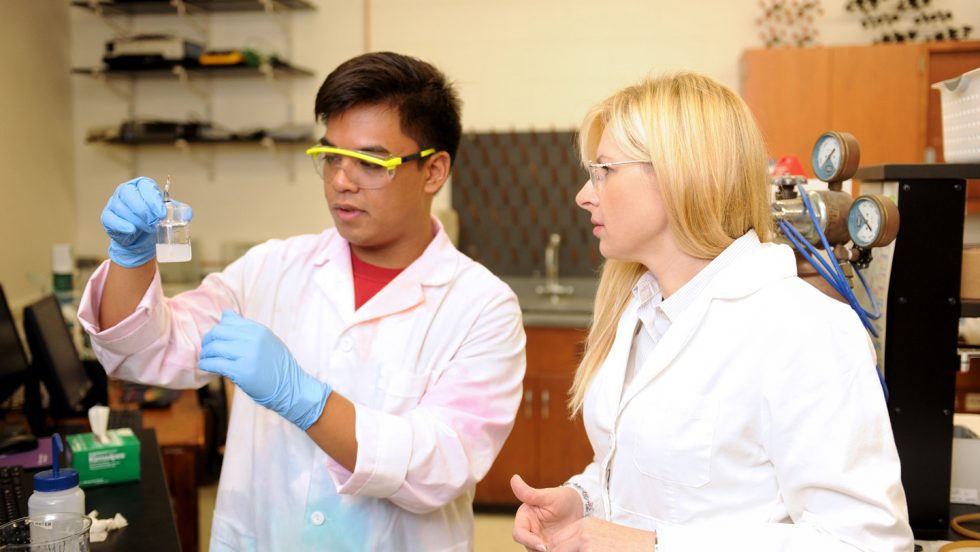
Pharmaceuticals save human and animal lives, but when they end up in our waterways, they present a dangerous form of pollution.
The popular antibiotic tetracycline, for example, is found in wastewater in heavily populated and livestock-rich regions. In nature, the drug promotes antibiotic resistance in disease-causing organisms and inhibits the growth of some terrestrial and aquatic species. Justyna Widera-Kalinowska, PhD, associate professor of chemistry, and her students at Adelphi University, with longtime collaborators at the University of Warsaw in Poland, have developed a new, earth-friendly way to break down the widely used antibiotic in our waters, which was discussed in an article recently published in the Journal of Marine Science and Engineering.
The popular antibiotic tetracycline is used to treat pneumonia and other respiratory tract infections, Lyme disease, acne, cholera, malaria and much more in humans. It is widely used in veterinary medicine as well, and is commonly added to the food of livestock. After consumption, more than 70 percent of tetracycline antibiotics are excreted and released as waste, which often ends up in our waterways.
In nature, the antibiotic promotes the development of antibiotic-resistant microorganisms, which can be harmful to human and animal health. The presence of tetracycline in the environment also inhibits the growth of some terrestrial and aquatic species.
Justyna Widera-Kalinowska, PhD, associate professor of chemistry at Adelphi University, is an electrochemist who studies the development and use of new nanomaterials to degrade industrial pollutants and waste materials in water; her focus is on light-activated, photocatalytic materials. She is particularly interested in the use of green energy—specifically, harnessing the power of sunlight to address critical problems.
Dr. Widera-Kalinowska involves her students in her innovative research and enjoys a long-term collaboration with Magdalena Osial, PhD; Krystyna Jackowska, PhD; and Pawel Krysinski, DSc, all Faculty of Chemistry at the University of Warsaw in Poland.
Recently, Dr. Widera-Kalinowska; Momoka Nagamine, an Adelphi University senior chemistry major at the time; and the University of Warsaw group worked together to develop a new catalyst that can cause the breakdown of tetracycline in the environment. The research team focused on the use of cadmium sulfide (CdS) nanoparticles, a chemical compound that functions as a semiconductor of electricity and is used in photovoltaic cell technology (solar power cells).
To test their hypothesis that CdS activated by sunlight could provide the catalyst to break down pharmaceutical compounds, the group tested their new photodynamic catalyst on methylene blue, a pharmaceutical agent that also ends up in the waterways, because of its bright blue color and the ease of studying its molecular structure.
Through their initial studies on methylene blue, they were able to gain proof of concept—the catalyst worked to break down the drug. The researchers then went on to the next step— quantitative studies on how well it worked. With a respectable 80 percent success rate, they then successfully applied the catalyst to tetracycline molecules.
The CdS treatment that Dr. Widera-Kalinowska and her colleagues have developed has numerous advantages over existing methods of breaking down tetracycline in the environment. The team’s new CdS-based photodegradation catalyst:
- Is synthesized in an easy and inexpensive method.
- Is 10 percent more effective than existing methods, coming in at 80 percent efficacy.
- Uses visible light, which is far more abundant than the ultraviolet (UV) light required by other methods.
Furthermore, the group has identified the molecular mechanism by which this catalyst works, whereas previous studies have demonstrated less efficacy and no insight into the molecular mechanisms of the photodegradation. By understanding the molecular mechanisms of how the CdS photodegradation catalyst works, scientists can carry the research and development forward in more insightful ways.
The results of this study were published in the Journal of Marine Science and Engineering after the editor saw Dr. Widera-Kalinowska’s students presenting at a research conference and invited her to submit a paper for publication. Dr. Widera-Kalinowska is passionate about taking students to research conferences and scientific expeditions to help prepare them for careers in science.
Next Steps
The next step in this research project will be to look at the products of the degradation. The group has shown that the tetracycline molecules are broken down, but what do those fragments look like and what are their impacts on the environment? The group’s ultimate goal is to develop a new technique to break the tetracycline down into its simplest components—carbon dioxide and water molecules.
Citation
Nagamine M, Osial M, Jackowska K, Krysinski P, Widera-Kalinowska J. Tetracycline Photocatalytic Degradation under CdS Treatment. Journal of Marine Science and Engineering. 2020; 8(7):483. https://doi.org/10.3390/jmse8070483